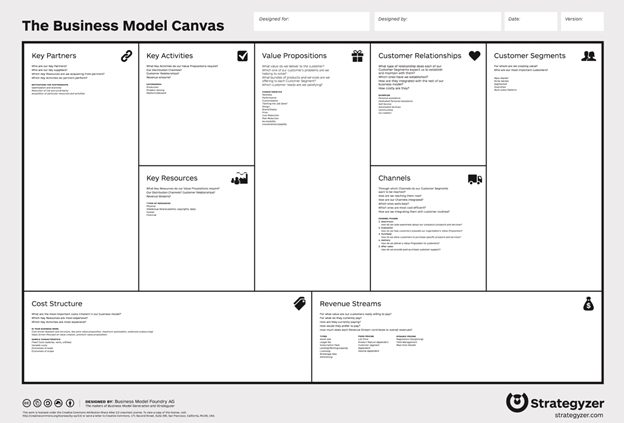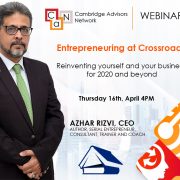Business Model Canvas
A powerful tool for entrepreneurs to define the key elements of a business model
Success of a business is defined by its ability to understand customer needs and respond to the market demands by responding with innovative solutions in light of the constantly changing environmental needs, market demands and technological advances. With these quick changes being thrown at lightning speed, often an entrepreneur does not have time to develop a full-blown business plan. Yet, venture partners still need to have businesses must have a clear and focused vision about their purpose, and their future activities must be aligned for future growth and sustainability. This is where the business model comes in.
Developed by Alexander Osterwalder and Yves Pigneur, the business model canvas designed a powerful entrepreneurial tool, Business Model Canvas, to help businesses develop and shape their ideas. While a typical business plan takes close to 100 hours to develop, the business model canvas is a succinct way to define the key elements of a business. For a startup or growing company, it is a good reminder of the important components needed for a business idea to work. A typical business model canvas is given below.
https://commons.wikimedia.org/wiki/File:Business_Model_Canvas.png
By Business Model Alchemist (http://www.businessmodelalchemist.com/tools) [CC BY-SA 1.0 (https://creativecommons.org/licenses/by-sa/1.0)], via Wikimedia Commons
While detailed explanations of the business model canvas is available at https://strategyzer.com/ The essential components are summarized below. The business Model Canvas is a one-pager consisting of nine blocks: customer segments, customer value proposition, channels, customer relationships, revenue streams, key resources, key partners, key activities and cost structure.
Before defining a Business Model…
A good business model is definitely a game-changer because it has the potential to give your business a scope for future. It has the potential to turn your failure into a big success.
But before a business model is defined, entrepreneurs need to first answer a critical question: What is the problem we want to solve.
Businesses aren’t just started without proper analysis of existing problems, and in the end, that’s what businesses are catering – solutions to customers’ problems.
Components of a Business Model
Once the entrepreneur has framed the problem, he or she needs to work on developing the following elements of the business model.
Customer Segments
The customer segment defines who the business is attempting to serve. Customer Segment is indeed the foundation of any business model. Segmentation is digging out your targeted set of the audience from a clutter. A business may have more than one offering to serve more than one customer segments – each value catering different customer groups.
Value Proposition
The Value proposition is defines how the business will solve the customer problem or satisfies a customer need. According to the authors of the Business Model Generation, “The value proposition is the reason why customers turn to one company over another…Value propositions may be innovative and represent a new or disruptive offer. Others may be similar offers, but with added features and attributes.”
Channels
Channels are the means by which the business brings the product, service or benefit to the customer. It is a bridge through which you communicate your offerings to your customer segments. They include entities who sell your products or services and after-sales service to your targeted customers. For this purpose, Alex Cowan recommends the use of AIDA.OR model (Attention, Interest, Desire, Action, Onboarding and Retention) and storyboarding to design ‘customer journey’.
Customer Relationships
Customer relationships are all about how a customer interacts with a company? How a customer interacts with an organization determines the most important elements – customer loyalty, trust and retention. This element of the business model would define the way that the business would build long term relationships with the customer.
Revenue Streams
The business would benefit from developing revenue streams that will make the model sustainable.. Revenue streams are often considered as ‘arteries’ of a business model. When business is catering multiple segments, there can be multiple revenue streams too. However, just listing down the sources of earning isn’t enough but to evaluate each on an individual basis whether it is beneficial for business is important. The key is to first analyze how important or big the problem is for a customer and whether he or she is willing to pay for a solution. If not, then opting for that particular source isn’t a good choice.
Key Activities
Key activities are important operations necessary to carry out in order to deliver your proposed value- they define the key operations of the business. This may include production, logistics, or service delivery. Key activities are of paramount importance because it helps in approaching customer segments, effectively delivering proposed value, building customer loyalty, and generating revenues. Key activities vary according to business types (product-driven, scope or infrastructure), hence focus is the same – how to best deliver the value proposition to our target audience.
Key Resources
Key resources are important assets and inputs required to make your business model work and deliver your proposed value. Resources can be of different categories including physical, financial, intellectual and human. Key activities will help define your key resources – what material is required, what kind of people should be hired, what equipment is needed, and much more.
Key Partners
Key partners are a nexus between key activities and key resources. These help in determining key partners and suppliers needed to make our business model work efficiently. Partnerships can be a major factor in businesses’ success or failure. An organization could be engaged in various partnerships, but the key is to identify the healthy one.
Cost Structures
Cost structures refer to the major cost heads incurred. While creating and delivering the value proposition, maintaining long-term relationships, and generating revenues, costs would be incurred. The Cost analysis section would list all major costs incurred by the business. This should be aligned with key resources and key activities. Key costs and key revenues will determine if the business is actually sustainable with respect to, and if there is a certain discrepancy, it definitely needs a detailed analysis as to whether the business idea is worth investing in.
Conclusion
Business model canvas is the foundation for creating your own success. It helps businesses stay focused and have a coherent view of multiple aspects throughout business lifecycle.
In the end, all you need to keep yourself whether the model makes any sense? Could be it done any other way, the better way? An effective model must pass the following tests:
- Does the model solve a real worthy customer problem?
- Does the model make a good explanation of how the business works?
- Are the main elements of business operations and external partnerships defiend?
- Do the costs and revenues make sense and will the business make a profit?
The business model canvas helps keep track of changes in decisions in a quick manner. While the document is not complete and cannot take the place of a detailed research, marketing plan, operations plan or business plan, the business model does give an overview of the model to keep team members on track.







Leave a Reply
Want to join the discussion?Feel free to contribute!